Repair of defective power supply
The entire windlass is above deck and can retrieve braided rope as well as anchor chain. Four bolts connect it to the boat and the backing for them is a bit on the flimsy side. As usual, Prout Catamarans decided to pinch pennies by using untinned, badly sealed wire to deliver power to the corrosive environment in the anchor locker.
Simpson-Lawrence's current "Horizon" series windlass wire size recommendations seem to be based on 10% voltage drops. However, our older "Seawolf" series windlass requires a 5% drop. For the 70 foot run to and from the battery compartment, and the 70A that the windlass draws under power, a 1/0 AWG conductor is appropriate.
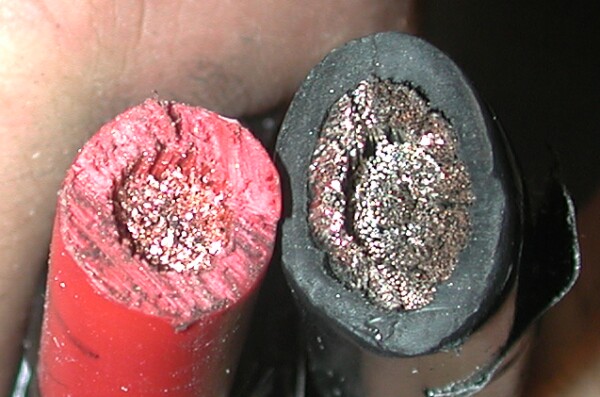
Just for fun I thought I'd include a picture of the Prout Catamarans wire for the windlass and the proper Simpson-Lawrence specified wire side by side. The untinned Prout Catamarans wire (left) weighs in at approximately 2AWG, while our replacement (right) is 1/0 tinned. Pulling the new wire through the conduit system looked impossible until it became apparent that the conduit was not constructed very well and easily came apart. For once, I am glad that Prout Catamarans' employees did not properly join pipes! The new wiring should afford less voltage drop and a cooler running windlass motor.
But undersized and untinned wiring is a recurring theme on our boat. While Prout Catamarans sent us a fax in the early nineties promising a wire replacement due to visible corrosion, none was ever installed.
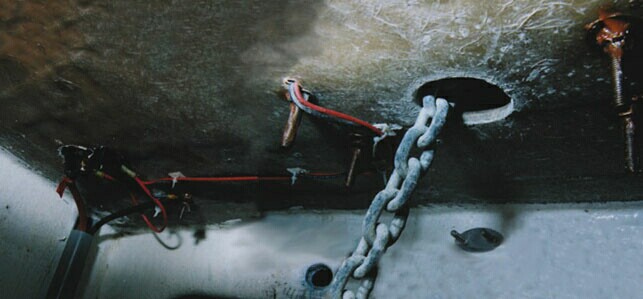
A historic composite picture of the anchor locker in 1999: At left you can see a PVC conduit that runs to the main saloon and the two conductors that come all the way from the Link Box. Also amusing is wire leading to the windlass which looks positively puny. It should be at least 8 AWG assuming it has a 105 degree rated insulation. We will replace the OEM wire if it does not measure up to ABYC standards.
Note the thick grease we put on all hardware to better protect it from the salt spray in the locker. The electrical connections to the right will be covered by a box in the future. That should keep corrosion to a dull roar.
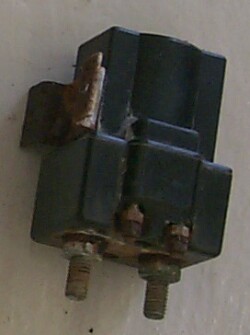 To the right you can see the last solenoid we'll ever buy for the windlass. It lasted for a few years before rust made it quit. No one should have expected it to last any length of time in an environment where it was not afforded any protection from the salt spray in the anchor locker. Boat builders usually use $2 enclosures to protect switches and solenoids from the elements. But that was evidently too much of an expense for Prout Catamarans, which just mounted the hardware to the underside of the deck. Besides the switch and the relay, the Seawolf 900 windlass has been a fairly reliable unit for us.
To the right you can see the last solenoid we'll ever buy for the windlass. It lasted for a few years before rust made it quit. No one should have expected it to last any length of time in an environment where it was not afforded any protection from the salt spray in the anchor locker. Boat builders usually use $2 enclosures to protect switches and solenoids from the elements. But that was evidently too much of an expense for Prout Catamarans, which just mounted the hardware to the underside of the deck. Besides the switch and the relay, the Seawolf 900 windlass has been a fairly reliable unit for us.
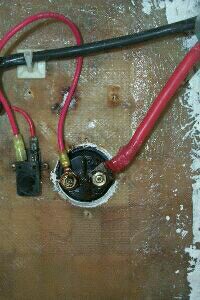 Here you can see the wiring as it comes into the foot switch, from the foot switch to the overload thermal breaker, and from there to the windlass. Also quite visible are the balsa sections behind the lower layer of fiberglass (the balsa shows up as rectangles). The white halo around the deck switch hole is due to our epoxy paint. The paint is meant to provide temporary protection against water ingress into the core that Prout Catamarans decided to omit. Eventually we will refinish all deck holes with epoxy. Note that the Simpson-Lawrence installation manual advocates the proper sealing of all deck penetrations.
Here you can see the wiring as it comes into the foot switch, from the foot switch to the overload thermal breaker, and from there to the windlass. Also quite visible are the balsa sections behind the lower layer of fiberglass (the balsa shows up as rectangles). The white halo around the deck switch hole is due to our epoxy paint. The paint is meant to provide temporary protection against water ingress into the core that Prout Catamarans decided to omit. Eventually we will refinish all deck holes with epoxy. Note that the Simpson-Lawrence installation manual advocates the proper sealing of all deck penetrations.
Particularly troubling was the widespread use of clear silicone to seal
components to the deck - the stuff has a rather limited lifetime and leads
to leakage sooner or later (we detected some leakage in all hull penetrations).
Replacing the silicone is somewhat bothersome as every trace of it has
to be removed first. We start by using scrapers to remove the big chunks,
then graduating from razor knives to de-waxing agent and wire brushes.
Only then can you be sure that the bedding compound you replace the silicone
with will actually stick.
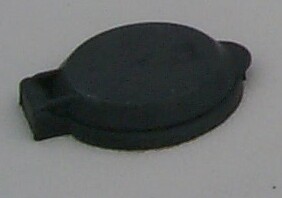 We replaced the foot switch with a covered version from West Marine that does not require a relay to deal with the currents of our windlass. Even better, the integral cover prevents accidental use - guests are not always as careful about where they set their feet as they should be. The cover brings us peace of mind and the black plastic should last a very long time.
We replaced the foot switch with a covered version from West Marine that does not require a relay to deal with the currents of our windlass. Even better, the integral cover prevents accidental use - guests are not always as careful about where they set their feet as they should be. The cover brings us peace of mind and the black plastic should last a very long time.
Best Estimate for Time Required:
| Remove existing hardware | 10 minutes |
|---|---|
| Make new wiring harness, hook up | 10 minutes |
| Paint, seal thru-holes, install new foot switch | 2 hours |
| Attach new wiring coming from Link Box, retrofit better motor hookup wire | TBD |
| Total | 2.33 hours |
|---|


